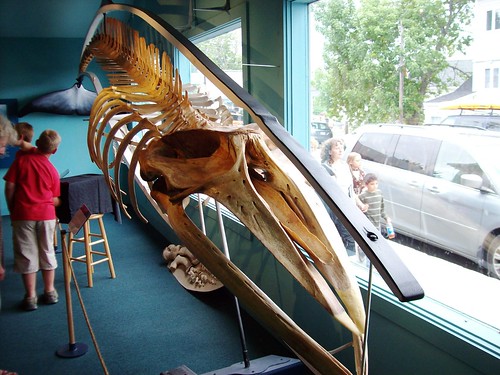Scientific Name: Balaenoptera acutorostrata
Other Names: Little Finner, Pikehead, Little Piked Whale, Pike Whale, Lesser Rorqual, Lesser Finback, Sharp-headed Finner
This is the smallest of all the rorquals (which are, by nature, large animals) and is a baleen whale. They are also particularly abundant and are found in oceans just about anywhere in the world. The Minke is usually distinguished from other whales to which it bears some resemblance (such as the Sei and Fin whales) by its distinctive dive sequence, head shape and relatively unscarred skin. Sadly, this is the only whale of the baleens that is still being hunted commercially.

Minke Whale under water.

Minke whale skeleton. Bar Harbor – Whale Museum.
Physical Characteristics
The Minke Whale has a very distinct pointed snout with a flattened rostrum, which adds to the sharpened effect. The body is black, dark grey or dark brown on the top with a white or very pale underside. The pale colour is also present as a band on the pectoral fins of some Minke subspecies.
There are between 50 and 70 grooves that run from beneath the mouth to just behind the pectoral flippers. This allows some flexibility so that the mouth can expand during the feeding process.
The dorsal fin is small and curved, but relatively tall, compared to other baleen whales. The two pectoral flippers are narrow, pointed and comparatively short. The tail fin has a slight notch in the centre with concave trailing edges. Adult Minkes reach a length of seven to 10 metres (or 23 to 33 feet) and a weight of between five and 10 tonnes.
Behaviour
Some Minke Whales can be quite inquisitive, even approaching boats. This is to their detriment in the cases of their approaching hunting boats. However, many shy away from any sort of human contact and are difficult to approach.
This whale is a fast swimmer, in comparison to others of its kind. It will emit between five and eight blows with intervals of less than a minute before diving under the surface of the water. Although the average dive lasts for about five minutes, it can last anywhere between three and 20 minutes. While it travels, it will usually only take one or two breaths between dives.
Occasionally, the Minke Whale will be spotted feeding just below the ocean’s surface.
Where to Find Them
Minke Whales can be found all over the world, but at different times of the year. Research suggests that individuals have home ranges. Minke Whales are known to enter estuaries and shallow bays, as well as sometimes feeding around islands during the warmer months.
Diet
Being baleen whales, Minkes filter their foods through large sieve-like structures in their mouths known as baleen plates. This allows only tiny fish and krill (or very small crustaceans) through.
Threats
Unfortunately, Minke Whales are still hunted commercially, which means that human hunters are, at present, its biggest threat. Additional threats are pollution and fishing nets, which both leave the Minke Whale with few defences against their tragic effects.

